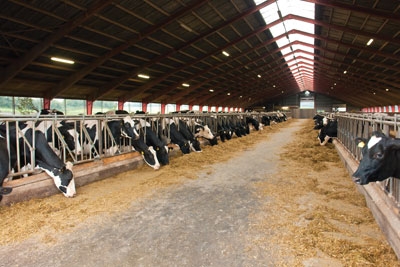
Features
Applications
Environment
Environment Research
Other
Research
Sustainability
Nutrient management plans: A study in cause and effect
September 18, 2012 by Manure Manager
 Researchers from the University of Connecticut and the U.S. Department of Agriculture tracked what happened when four dairy farms implemented nutrient management plans over several years.
Researchers from the University of Connecticut and the U.S. Department of Agriculture tracked what happened when four dairy farms implemented nutrient management plans over several years. It seems practical on the surface. Nutrient management plans (NMPs) should supply plants with ideal amounts of nutrients, minimize runoff and maintain or even improve the soil condition. And the farmer behind the plan would work with a set of conservation practices designed to reduce harmful pollutants while still obtaining optimal crop yields.
However, many U.S. concentrated animal feeding operations (CAFOs) now produce excess manure nitrogen and phosphorus compared to the actual nutrient requirements needed by cropland. The Clean Water Act required several agencies, including the U.S. Department of Agriculture, to develop a unified strategy to minimize the effects of CAFOs on water quality and public health. Yet, each state continues to operate under a different set of guidelines for NMPs, with most heavily suggesting farmers develop field-by-field records of nutrient applications. Currently, only Delaware and Maryland have laws requiring all farmers to implement NMPs.
In a new study, funded in part by the Agricultural Food Research Initiative of the National Institute of Food and Agriculture, researchers from the University of Connecticut and the U.S. Department of Agriculture tracked what happened when four dairy farms implemented NMPs during a several year time span. The scientists compared pre-plan practices with recommended management plans to evaluate whether manure and fertilizer management has a significant effect on the nutrient status of soil and corn tissue. Numerous factors were considered, including the number of livestock, cropland acreage, nutrient status of the cropland, manure production, manure management, and fertilizer management.
During the first year, each farmer kept field-by-field records for manure and fertilizer applications, but made no changes to the management of nutrients. The information collected, developed a field-by-field recommendation for manure and fertilizer management, in the subsequent implementation years. The rate of manure recommended was based on the amount of phosphorus needed by the crop, which researchers estimated from soil test results. If the farm had excess manure after fulfilling the crop’s phosphorus needs, recommendations were made to apply manure at a rate equal to the amount of phosphorus expected to be removed by the crop. If the farm still had manure left over, it was to be applied to fields to meet the nitrogen requirement for the crop and to fields with a low potential to export phosphorus to water bodies. Chemical fertilizer recommendations were made after all manure was allocated.
Soil samples were routinely collected by farmers or crop advisers and analyzed at the University of Connecticut Soil Testing Laboratory. Samples were taken from the surface 30-cm layer in late spring when the corn was 15 to 30 cm tall. The samples underwent pre-sidedress nitrogen tests (PSNTs), which indicate how much nitrogen is available in the soil.
Cornstalk samples were also collected for corn stalk nitrate tests (CSNTs), which provide a retrospective assessment of a season’s nitrogen management. Farmers collected 15 cornstalk samples from each field during the period ranging from one week prior to harvest through one day after harvest.
In the end, results were surprisingly mixed, with little decrease in the concentrations of nitrate in PSNTs and CSNTs tests.
The documentation of improvements in nitrogen and phosphorus management after the implementation of NMPs also proved to be a difficult task and for many reasons. But researchers suggest, by digging deeper and for a longer period of time, all may come closer to the needed outcome.
The complete results from this study can be found in the just released issue of Agronomy Journal. View the abstract at https://www.agronomy.org/publications/aj/view/104-2/aj11-0316-pub.pdf.
Information courtesy of the American Society of Agronomy (ASA), the Crop Science Society of America (CSSA), and the Soil Science Society of America.